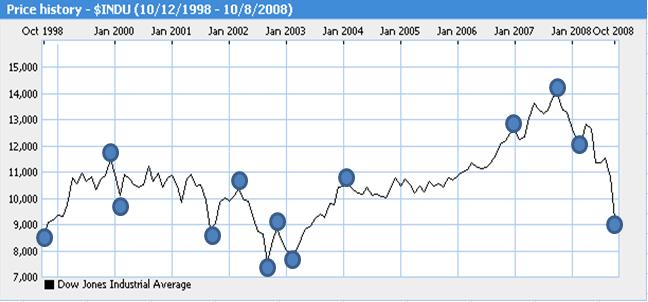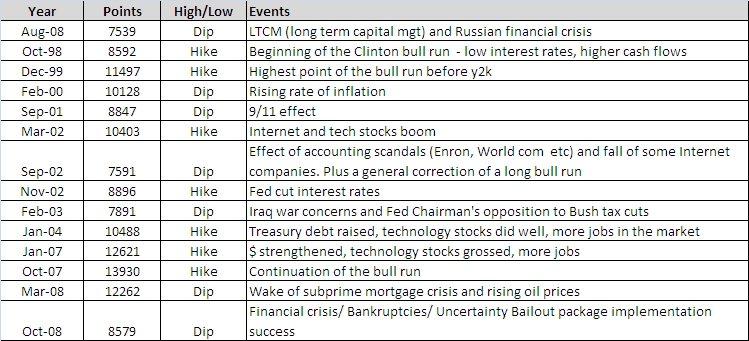[A layman’s view to understanding the present US Financial Crisis]
Before we get into the events, it is important to understand certain basic terminology and mechanisms.
Mortgage backed securities – Banks have two primary functions. Accept deposit and lend loans. When a borrower approaches a bank for a loan, the bank (after due diligence of the creditworthiness of the borrower) lends him money from the funds it has accepted as deposits. The bank charges a rate of interest for the time the borrower takes to repay the loan.
Given this simple mechanism, the bank may face a problem when the market rate of interest fluctuates or when it may run out of funds for further lending at a certain point.
In order to solve these problems the concept of mortgage backed securities was introduced. In this system, the bank issues bonds against the loan and sells it to investors at a rate of interest that is equal to the interest payable by the borrower on the loans.
For e.g, say X borrows $1,000 for a home loan at 8% interest p.a from Bank of America. The bank may sell 100 bonds worth $10 each to an investor promising an interest of 8% on the amount. This way the interest payable and receivable are cancelled out by the borrower and the investor. So basically whatever the borrower pays as interest goes to the investor as his return on investment. The problem arises when X defaults his interest payment.
Subprime lending crisis – Check out my earlier post, Crash, boom, bang!
Credit crunch – A situation in which there is a sudden reduction in the availability of loans or increase in the cost of lending by banks and financial institutions. This is usually caused when banks and institutions have suffered losses in lending and have bad debts.
Bankruptcy – A legally declared inability or impairment of ability of an individual or organization to pay their creditors. This is also known as Chapter 13 in financial circles.
Bailout – A situation where a bankrupt or nearly bankrupt entity, such as a corporation or a bank, is given a fresh injection of liquidity, in order to meet its short term obligations. Often bailouts are by governments, or by consortia of investors who demand control over the entity as the price for injecting funds.
Housing Bubble – Is a type of economic bubble that occurs periodically in local or global real estate markets. It is characterized by rapid increases in valuations of real property until they reach unsustainable levels relative to incomes and other economic elements.
Foreclosure – Is the legal proceeding in which a mortgagee, or other lienholder, usually a lender, obtains a court ordered termination of a mortgagor’s equitable right of redemption.
So… what just happened?
7th September 2008 – Fannie Mae and Freddie Mac takeover
Fannie and Freddie are two very large mortgage companies that are sponsored (but not run) by the Federal Government. Their primary business is to guarantee the mortgage bonds to the investor in case payments are missed by borrowers. They also create a fund(as in insurance) to make up for losses in cases of default. This fund is created by taking a certain percentage of the payments or from sale of the house.
Since Fannie and Freddie, the Government backed institutions provided guarantee, the mortgage securities industry flourished.
When the subprime crisis started in 2007, all the defaults, bad credits and foreclosures largely affected Fannie/Freddie’s business. The two have more than $5 trillion in outstanding mortgage backed securities. The share prices hit rock bottom.
The Government had no option left but to take over the two companies and infuse money from the treasury to clean up the mess.
14th September 2008 – Bank of America acquired Merrill Lynch
ML is a large investment banking and financial firm that incurred billions (app. $51billion) in losses due to investing in mortgage backed securities that went bad during the subprime crisis. The company was recently acquired by its rival, Bank of America.
15th September 2008 – Lehman Brothers bankruptcy
Lehman Brothers is a 158 year old global financial services and investment banking company. It had ventured into mortgage backed securities and during the subprime crisis, one of its firms was closed. The company lost huge sums in the form of goodwill and its share prices tumbled. Neither Bank of America nor Barclays who were called for deals to buy the Lehman, made a bid. The Government also refused to bailout the company from bankruptcy.
16th September 2008 – AIG bailed out
AIG, the largest insurance company in the world is being bailed out by the Government. The problem is the same; loss due to subprime crisis resulting in bankruptcy. AIG’s main line of business is insurance services but the company had diversified and entered other areas including mortgage backed securities.
The Government decided to bailout AIG due to its enormous funds (trillions), public stake, global ties across industries.
17th September 2008 – WaMu Auction
Washington Mutual or WaMu is a former mutual fund company which later became the third largest mortgage lender. In 2007, the company suffered huge losses in its home loan divisions due to the subprime crisis which resulted in layoffs and affected stock prices. Now the company has hired Goldman Sachs to take care of its auction.
Why this happened?
As you would have noticed by now, the answer to the ‘why’ is quite clearly the subprime crisis. Let us drill down further.
In the early years of this decade, in order to remove the sluggish nature of the economy, the Federal Reserve lowered the mortgage interest rates. This resulted in a trend of rising housing prices. Unlike traditional loan diligence, the borrowers were given loans without looking at their creditworthiness. Instead, people who were lower on their creditworthiness rating were charged a higher rate of mortgage interest. Because of the housing bubble and the high demand for loans, banks and financial companies didn’t waste their chance to make a quick profit out of the situation. Loans were endlessly given out. Very high rates were charged. These loans were in turn sold as mortgage backed securities to investors. This business picked up across companies in the financial industry and everything seemed to go well until the bubble burst.
When the interest rates reached a level where it was too high to afford by many borrowers, lot of the loans went bad. This in turn had an impact on the investments in mortgage backed securities. The demand for Fannie and Freddie guaranteed securities decreased. Foreclosures increased, house prices plummeted, and lenders incurred huge losses unable to value assets resulting in liquidation.
A major argument and an increasing realization is that there was very less regulation imposed on the financial instruments by the Federal Reserve/ Government.
Who gets affected?
The real estate crisis infected the financial markets. This led to enormous job losses and money losses. The financial institutions were unable to lend money to business that really needed it to grow. This is leading to a snowball effect and is slowly hitting every industry one by one. This, coupled with the rising and highly fluctuating gas prices is resulting in a huge economic recession instead of what was hoped to be only a slowdown in the US.
Thats not all. Most of the afore-mentioned companies operate globally. They have presence in all continents. And in this global economy, a financial meltdown in the US market is bound to have far reaching impact on world markets.
Solutions?
The current Wall Street crisis is touted to be the biggest since the Great Depression that hit the US economy in the 1930s. It has been a chain reaction with people across industries suffering. Though the Government has been working on immediate short term relief like the economic stimulus package, it is very obvious that the economy needs a long term sustainable solution to get out of this mess.
The 2008 Presidential Elections will certainly be one of the most important of its kind in a very long time. And the policies, ideas, determination and resolve of the next President will be the crucial factors determining this election.
references
www.wikipedia.org ; www.nytimes.com ; www.spiked-online.com

